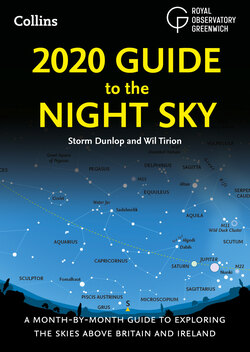Читать книгу 2020 Guide to the Night Sky - Storm Dunlop - Страница 7
ОглавлениеThe Winter Constellations
The winter sky is dominated by several bright stars and distinctive constellations. The most conspicuous constellation is Orion, the main body of which has an hourglass shape. It straddles the celestial equator and is thus visible from anywhere in the world. The three stars that form the ‘Belt’ of Orion point down towards the southeast and to Sirius (α Canis Majoris), the brightest star in the sky. Mintaka (δ Orionis), the star at the northeastern end of the Belt, farthest from Sirius, actually lies just slightly south of the celestial equator.
A line from Bellatrix (γ Orionis) at the ‘top right-hand corner’ of Orion, through Aldebaran (α Tauri), past the ‘V’ of the Hyades cluster, points to the distinctive cluster of bright blue stars known as the Pleiades, or the ‘Seven Sisters’. Aldebaran is one of the five bright stars that may sometimes be occulted (hidden) by the Moon. Another line from Bellatrix, through Betelgeuse (α Orionis), if carried right across the sky, points to the constellation of Leo, a prominent constellation in the spring sky.
Six bright stars in six different constellations: Capella (α Aurigae), Aldebaran (α Tauri), Rigel (β Orionis), Sirius (α Canis Majoris), Procyon (α Canis Minoris) and Pollux (β Gemini) form what is sometimes known as the ‘Winter Hexagon’. Pollux is accompanied to the northwest by the slightly fainter star of Castor (α Gemini), the second ‘Twin’.
In a counterpart to the famous ‘Summer Triangle’, an almost perfect equilateral triangle, the ‘Winter Triangle’, is formed by Betelgeuse (α Orionis), Sirius (α Canis Majoris) and Procyon (α Canis Minoris).
Several of the stars in this region of the sky show distinctive tints: Betelgeuse (α Orionis) is reddish, Aldebaran (α Tauri) is orange, and Rigel (β Orionis) is blue-white.
